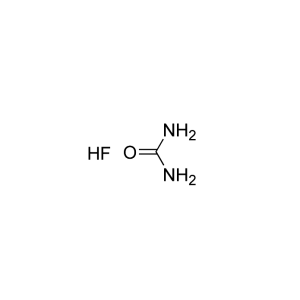Hydrogen Fluoride in Urea

- Fluorination Reagents
- Urea, monohydrofluoride
- Carbamide fluoride
- Hydrogen Fluroide-Urea
- Urea-HF
- HF
Physical And Chemical Properties:
Appearance: Clear to light brown
Physical State: Liquid
Odor: Odoriferous, acute, strong
Specific Gravity: (Water = 1.0) 1.27at 59ºF (15ºC)
Solubility In Water: By weight %, 100%
Incompatibilities
Toxic gases carbon dioxide, hydrogen sulfide and hydrogen cyanide may result from carbonates, sulfides and cyanides. Exothermic process may occur in the presence of alkalis and oxides. With concrete, glass and other silicon materials, silicon tetrafluoride gas may occur. Glass containers may breach or break apart from pressure. Flammable and explosive hydrogen gas may result in the presence of some metals. Will behave as a corrosive to many and various materials such as organic material, (e.g., rubber, leathers). Water may cause a large amount of heat and violent reaction.
About Urea HF
Some of the problems with HF can be minimized by combination with an amine, thereby making the reagent much less volatile and safe to use in ordinary lab glassware. Such reagents are suitable for desilylation and displacement of alkyl and aryl halides. The electron density of the fluoride anion is somewhat reduced compared to HF itself. These reagents are more effective when less electrophilic substrates are activated for nucleophilic attack. Epoxides, activated by their ring strain, convert well to 1,2-fluoroalcohols. Olefins, activated with an oxidant like NBS, convert to 1,2-fluorobromides.1 Either of these products can be converted to fluoro-olefins, which can be subsequently converted to difluorides. The same combination of reagents can convert thio ketals to geminal difluorides. Alcohols and phenols, through their intermediate xanthates, are converted to trifluoromethyl ethers.2
1 Markovnikov addition of fluoride.
2 Org. Process Res. Dev., 2008, 12, 308 and references therein



